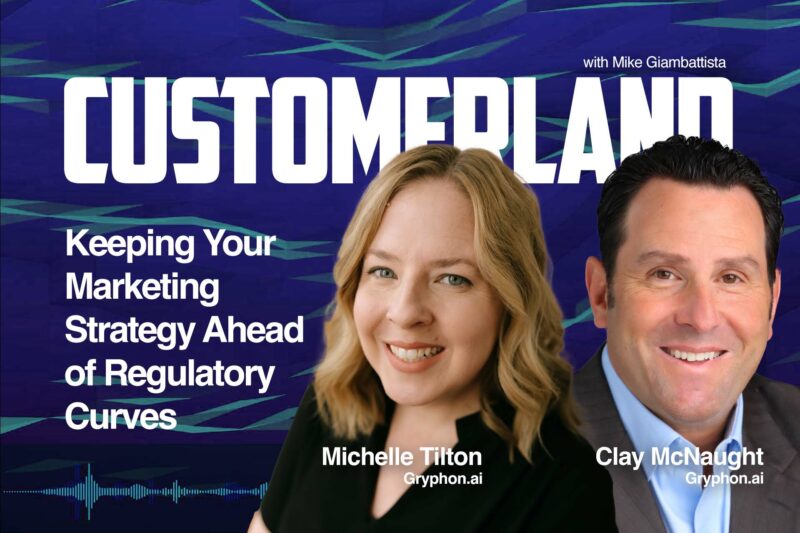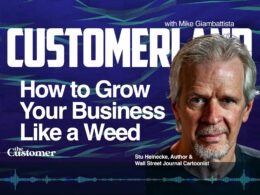Discover the crucial insights on maintaining compliance in marketing communications with industry experts Clay McNaught and Michelle Tilton from Gryphon.AI, who join us to demystify the complexities of navigating current FCC regulations. Their expertise illuminates the potential legal pitfalls that businesses may face with even minor missteps in outbound communication. As we dissect the journey towards ensuring compliant dialogue, learn the importance of staying ahead of the curve to protect your business from the costly repercussions of non-compliance.
In this episode, we cover everything from the growing emphasis on explicit opt-in consent to the increasingly severe fines for non-compliance, which can pose existential threats to companies across industries. The discussion pivots around the transformative effects regulatory changes are having on marketing strategies. For CMOs and marketing professionals, we share pragmatic steps to maintain lead volumes and pivot towards a quality-centric marketing approach, highlighting the necessity of establishing a respectful culture around customer data privacy.
Finally, we tackle the pressing issue of DNC and TCPA violations, emphasizing that the absence of solid communication policies can put your organization in jeopardy. The rise in class-action lawsuits and penalties is a wake-up call for companies to re-evaluate their compliance strategies. Join us for a comprehensive breakdown of these intricate topics, ensuring that your company not only survives but thrives in a landscape where respecting consumer rights isn’t just law—it’s good business.
See the full transcript below
Mike Giambattista
Today I’m honored to be talking to Clay McNaught, who is COO of Gryphon AI, along with Michelle Tilton, who’s VP of Marketing at Gryphon AI, about a topic that we all believe isn’t getting the spotlight it really needs, and this is not a promotional topic. It’s scary, you better pay attention to it kind of a topic. So, with that as a setup, thanks, clay, and thanks, Michelle, for joining me. Really appreciate this. And since I’ve done such a high level job of introducing you, maybe you could just talk to us a little bit about what you do at Gryphon, your roles there and maybe even, just for the audience’s sake, what Gryphon does, what you’re all about. Go ahead, clay, take that.
Clay McNaught
Okay, Good morning, Mike. My name’s Clay McNaught, I’m the Chief Operating Officer at Gryphon AI and I’ve been with the company for about a year and really what we focus on is end to end compliant conversations, communications and so on the front end, everybody’s aware of the do not call list TCPA. We have many TCPAs, we have a new ruling from the FCC and so at the beginning of a conversation, it’s ensuring that you’re contacting the right people at the right time and then taking it one step further into the conversation, ensuring that you’re having a compliant conversation, especially with the new rules that came out. Ensuring that if an individual wants to be contacted about a specific service, that that conversation pertains to that service, and then through that conversation, especially with some of the caveats and how this is going to impact sellers, really putting your best foot forward and presenting, from an enablement standpoint, that individual, providing the right information at the right time to be able to either secure a sale or have a quality conversation, and then, at the end of the conversation, having the ability to understand and measure the overall success and quality of that conversation, is really at a high level.
There’s a lot more to it, but we’ve been doing this, definitely on the compliance side for over 20 years and really our passion is the fact of that. We can provide real time compliance or certification. And so, if you look at the current landscape, organizations either have IT firms that are building it manually, which we’ve seen and you look at the impact that if somebody has an opt out from text messaging, that that has to be honored within a 24 hour period. Some large enterprises packaged together these big marketing campaigns and it can take about three, four months for them to get all of the data, all of the contact information, and then, once that campaign is released, you have no idea what changes have been made or areas in which you’re not compliant, and then you send up a blast marketing campaign that could have tremendous exposure as it relates to FCC and class action.
Mike Giambattista
Yeah, huge, and I’m looking forward to kind of unrolling the whole FCC ruling as it stands. But first, maybe, Michelle, tell us a little bit about your role at Gryphon and what you do there.
Michelle Tilton
Sure, so I’m the VP of marketing, so kind of a broad term that encompasses all of our go to market strategies and thought leadership relations, and this is a big part of our thought leadership. So we pride ourselves in the space of being on top of all of the rulings and regulations that continuously change the landscape so our customers know what’s going on and can understand what’s coming down the pipe. So a big part of our strategy really is to educate the both customers and prospects, so that things like Clay just mentioned don’t happen to them and they continuously have compliant conversations, inbound and outbound.
Mike Giambattista
I wanna, if I can, I wanna try and set this conversation up by going back a few years, to the when GDPR was first announced and CCPA and all of its variants that kind of popped up later there and what I’m just going to say was the state of the realization that the landscape was changing back then and it’s been an interesting thing to kind of watch evolve, you know, as people started to recognize uh-oh, this thing has teeth in it.
I better comply, what’s involved in compliance, what tools you need and what kinds of oversight you need to manage. That has become an industry unto itself and I kind of feel like this new FCC rule, which is just kind of a node on an existing set of rules they’re all pointed in that same direction really has the ability to maybe even inadvertently change the lead gen lead conversation landscape in just as much of a wholesale way. I don’t know how you feel about that, but to me it looks like, hey, wait a second. We just are about to become all at risk here because of the way we’re going about doing business. Your thoughts on that, and I’ll drop this in front of you first, clay, and I’d love to hear your thoughts after that, Michelle.
Clay McNaught
Yeah, your spot on, mike, and really it’s. You know we think of things as a free market, meaning we can contact anybody at any time about anything, and the reality is that the FCC is really trying to force more of an opt-in specificity for email to text messaging. You know, for example, like comparison shoppers, websites and lead generators now have to obtain consumer consent to receive automated communications rather than simultaneously having a single consent applied in multiple telemarketers. So if you’re looking for a home loan, saying oh, I’m looking for a home loan, all of a sudden that blasts out to a number of mortgage companies. Now it will have to be more focused on specific organizations selling a specific service that aligns with the consent by that consumer. So, taking it one step further, you know this consent and one-on-one consent is really going to end the practice of robo-calling and robo-text from unrelated and unexpected sellers and solicitors. It’s really going to, and even in Europe, you know Europe has, with GDPR, an opt-in where an individual has to opt in for a seller to be able to reach out to them, and I think that’s the direction we’re going, and so it’s really going to force sellers and leads can still be generated. It’s all about, you know, using automated systems and so you’re still going to have that practice.
But you know there’s been under just under 2000 TCPA lawsuits this year and looking at these and you know I don’t think that the goal is to really hurt the SMBs, the small and medium businesses, but from an enterprise perspective, you really have to focus on what you’re doing and how you’re doing it because you know, just in October and November we’re seeing that of the suits that were filed, up to 70% of those are class action and we provide a list and there’s hundreds and hundreds of attorneys, there’s serial plaintiffs that are aligned with 10s, if not hundreds of different suits, and so it’s there are organizations that are looking for, you know, these groups or these enterprises to miss a step and then they end up soliciting and reaching out to say if you’ve been contacted.
And you know when you talk about, you know the overall magnitude of this, even though you know the fines from you know how they’re advertised range from $500 to $1500 per violation. The TCPA has also taken a cap, or there’s no cap, on the overall liability. So you know we, I think this year at the beginning of the year, we saw almost a billion dollar fine for a MLM company that had 1.8 million solicitations.
Mike Giambattista
Goodness gracious, that’s just. I want to let that number hang in the air here for a minute because that’s just huge. I mean that’s meaningful in a massive way. Okay, Michelle, I wanted to just since you’re in a marketing role, you have to pay attention to kind of the pulse of the market, of your market, I’m sure in some way. What’s your feeling on the awareness of this kind of regulation right now? Say, just start with awareness, and then, in the broader industry that we all serve, how are they dealing with it, or are they? It’s just kind of like a there’s something else on the horizon I can’t get to right now.
Michelle Tilton
So this one’s kind of interesting because I do feel like what you said earlier holds a lot of merit. That I feel when I we went through CCPA several years ago the very first round of CCPA I worked in a data and analytics company, so we were heavily impacted there and I think a lot of the folks who aren’t truly lead generators Maybe lead buyers have heard this news about the FCC’s ruling and are kind of like well, let’s just see what happens. Or Maybe, you know, maybe we’ll have to change a few things. Similar to the CCPA. Once you get into it and you really sit down and say, okay, we have to address this right now, you’re going to realize how far behind you are if you haven’t started, because that’s kind of the whole. It’s so similar in terms of how these rulings are quietly came down the pipe and now all of a sudden, people like us who are in it are very, very aware of what the impact will be in six months.
But I don’t know that all the companies who leverage that marketing channel are fully aware of the implications. And it in similar to CCPA it also and it requires you to unwind every piece of process that you currently have internally and truly understand every single piece of that process To ensure that you’re doing it correctly going forward. So I you know, I think there’s a big Push of people who know this has happened and they say, wow, this is going to be big, but I don’t think they’ve unpacked how it’s going to truly impact their org until they sit down and say, okay, now is the time we have to address this and it will be huge. It’ll be huge from losing an entire channel, potentially as a marketer. That that doesn’t just. You can’t just make that up in six months. You have to plan now in order to recapture that audience and really, truly get back to that missing channel.
Mike Giambattista
Or if you’re you know other side of that, if you’re an enterprise level lead generator mm-hmm. You may be on a business if you’re not careful.
Michelle Tilton
Or you’re going to have to get really creative on ensuring your partnerships with the largest enterprises so that you can get that one-to-one seller consent. Yeah, you know more mass programs, but that limits their whole audience. Now, from you know, SMB is almost completely taken out of the picture.
Mike Giambattista
Yeah, you know I was. I was looking at the, the language of the ruling, at least the summary language. I didn’t get too deep into the weeds there, but the ruling Seems like it was crafted to target, just as you said, clay, the, the robo-callers and spammers. Mostly that’s the target. But this, this seems to me like the way it’s crafted. The implications go far beyond that. The user set.
You know, as we’ve been talking about here, if you buy Leads on a third-party basis from anybody, you’re now impacted somehow and the risks, I think, probably have yet to be quantified, but they’re probably going to be significant. I guess my early take on this ruling is it’s pretty scary, but it also seems like, if you permit me, a kind of a dumb bomb approach, like we want to take care of the robo-callers and Eradicate those people as best we can, but in so doing there’s a lot of collateral damage, that’s that other legitimate, well meaning, well designed, well run enterprises are probably going to catch because of what these robo-callers have done. So, even though I didn’t see language that anywhere expressly pointed towards a legitimate enterprise use of these leads, it Seems like, by implication, you’re still getting the finger pointed at you. Thoughts.
Clay McNaught
Yeah, guilty before proven innocent.
Mike Giambattista
Yeah, there you go Right.
Clay McNaught
Yeah, and you know, I think you’re, I think you’re right that it’s very broad. But I also think that you know, from what we’re seeing and the fines that we’re seeing, that the FCC doesn’t believe that everybody is taking this seriously. And you know, part of this ruling too is that wireless companies have to block kind of the red flag robo-texting numbers, which is one step because some of a lot of those are overseas and so it’s preventing that. But you know what we’re seeing and even right now, when you say it’s a crackdown, you know we have organizations because you know DNC and TCPA, you know doesn’t just have an umbrella over the US where there’s just single rules that that sellers have to abide by.
We have now many TCPAs and we have states you mentioned CCPA. We have states that are coming out and creating their own rules around this type of not only solicitations but also when you can call, how many times you can call, if you can record the fact that if you’re doing outreach you have to divulge a certain amount of information upfront and you know, use the guilty before proven innocent. If you can’t defend yourself, meaning if you don’t have a recording or a transcription of that conversation where you can defend your position, then it’s almost impossible for you to be able to protect yourselves. And we have customers and we’re seeing people that are coming out and they’re choosing not to market in certain states because they don’t have these checks and balances in place.
Mike Giambattista
Yeah, a big chunk of your outreach just vaporized effectively. So let’s talk practicalities for a minute. You’re an enterprise user of these leads or something like them. You see that you’re potentially at risk here. What is a CMO to do about that? How do you kind of, once your light bulb starts going off and I think that’s probably step one is to like please, light bulb go off. What do you do? How do you navigate that?
Michelle Tilton
Yeah. So I think there’s the navigation of your provider and then there’s the navigation of internal, internal. How do we, how do we navigate this for generating our own leads? And I think the first thing is to understand a where all of these leads are coming from. In every single provider, you’re getting the leads from which you should know, which anybody should know. But step one document all of that, and step two is Understanding if you can still receive generated leads from them, provided that your company is one of, let’s say, a checkbox on a form fill that specifically enables you to call that lead.
You know from a consent to that company name about that key topic, by the way, because that’s another piece of that ruling. So you know, if I’m a bank, I have to make sure I’m calling about mortgages and not trying to switch to another topic like Auto loans or something, but anyways. So the first thing I’m going to do is really take an inventory of those lead generators and see when do I have the potential for falloff in terms of lead volume. And then, how do I, how do I make up that volume? Through other lead channels or traffic? And I think there’s a lot of things I thought about last week when we saw this pass, where Marketers are going to have to really focus on quality of what they offer, differentiation.
So when I’m one of ten mortgage providers on a form fill that the consumer is On top of mind, enough for the consumer for them to select my company because that, now that you have that push-pull marketing part of that, now, right, it’s almost like you’re going to have to market for the lead that might even be on the lead generators website to be top of mind. So there’s that. There’s increasing traffic to your own site, right, increasing lead volume. You can buy traffic. You can buy. You can buy traffic through programmatic and Google ad words and those different types of channels.
But now your offer better be really compelling for that consumer to provide their information. So I’d be doing a whole lot of Estimation of lead volumes and how we can make those up in other channels, and, and then I would think more holistically about the value we bring to those prospects to make sure that we are the one selected, which is Seems like an easy thing. We should offer consumers what they want to hear and what they want and truly, truly give them what they’re looking for. But that requires an entire orchestration of Creative and content and positioning, and so there’s a lot to unpack there, and hence why the six month window is not very long at all.
Mike Giambattista
No, and not to put words in your mouth at all, but it seems like again, once the light bulb goes off and you’ve decided how you want to approach this, there are, there are entirely new set of tools that you’re probably going to want to deploy to ensure that you are compliant, to understand, on a message basis, what the real, genuine quality of your messaging and the channels and the creative and everything goes into it Really is.
And isn’t that really? You know the, the brass ring that all of marketing kind of tends towards. But it seems to me like this ruling and so many others that are kind of pointing in that same direction are forcing the issue. It’s forcing marketers to go back to a quality mindset where we’ve been so much about quantity in the past, and maybe that’s a, maybe that’s a. You know a sliding scale one to the other, but it seems to me like it shouldn’t be quite so binary, like it’s either one or the other. You really need quantity and you need quality, and I talked to marketers all day long and everybody’s Intent on quality, but not necessarily focused on quality. So maybe this is kind of repoints the conversation. I don’t know.
Michelle Tilton
No, I eat your spot on. I think internally, when we had our first conversation clay and that question sort of popped up I think the first thing I said is marketers are going to have to provide quality. They’re going to actually have to focus on quality and then and quality at scale it’s always the conversation, right? I think every marketing group has that conversation all the time. We need, we need leads, but they need to be quality. How do we find that balance? And I think that’s always going to be a tough choice. But when you start seeing that quality converts that a higher percentage than quantity, you start seeing that impact. You can make that argument a little easier. But I I don’t think you put words in my mouth at all. I think that’s exactly what I said the first time we talked about that internally, it’s precision versus casting a wide net and trying to see what you can catch.
Mike Giambattista
Funny thing about marketers, though being one myself, is that we have a really well developed sense of the nuance of language. I’m being kind to myself and my peers here. Well, we will always say, and I think we will always believe, that we’re that we’re. We’re working out quality as we go, but our KPIs, our bonuses, all of our incentive structures are largely based on quantity metrics. So there’s a lot that has to change there, behind the scenes as well.
Michelle Tilton
Yeah, I think and it we have those conversations and our group internally too it’s we look at a lot more metrics and that’s a probably different conversation than this one. But we look at a lot more metrics that take us all the way through the funnel, not just MQLs, and flip them over and hear the leads. We tend to look at it much more holistically all the way through the funnel, through Pipeline, through close one close lost and why and which channels are producing the quality in those buckets of one lost. So I do think that you know, I think we tend to do a pretty good job internally of being honest with ourselves there and Trying to develop sort of that balance. But I do know from being at other organizations that there’s always pressure for more and that can drive to less quality, less quality leads coming in the door.
Mike Giambattista
Yeah, I’m curious, clay, from an operational standpoint your COO at Gryphon and this doesn’t necessarily apply universally, but as someone who runs operations in a decent-sized organization these kinds of considerations here from the FCC’s ruling are Going to apply to COOs in all kinds of industries are affected here. So there’s an operational series of operational Complexities that have to be dealt with as well. I don’t know if you have any thoughts on how Others in your, in your, position might end up navigating that.
Clay McNaught
It’s really understanding your operation and, and One of the changes that we’ve seen Post-covid is is the fact that a lot of organizations and large organizations are working in a distributive environment, which means you don’t have the controls of a single platform that everybody’s dialing out on. You’ve got people on their personal cell phones and If you’re on your personal cell phone, you can’t control who you’re calling, no idea whether they’re on a do not call list. You’re violating TCPA and what’s happening is is that, with these class action suits, they’re identifying and finding all of these groups, bringing them together to provide a suit against an organization. And so I would say, first and foremost, it would be a situation of, you know, are we at risk? What are the areas of risk? Can we alleviate the risk? And if we alleviate the risk, how are we ensured that the risk is alleviated?
Because a lot of times, you know, as I described earlier talking about, you know, building these marketing campaigns you really don’t understand the liability until it’s too late, and so getting in front of it and ensuring that that you are, you know, compliant with all of these guidelines is is paramount, and so what that means sometimes it’s overwhelming. It department say, well, we can build it in-house. And so now you’re building applications, you’re running those, and again you don’t have the peace of mind to fully believe that you’re compliant across the board with your organization. And so it’s, it’s a big deal, and you know our fear and we’ve seen this is you know people don’t address it until it’s too late right.
Mike Giambattista
I mean just to go back to the earlier part of our conversation, with GDPR and CCPA and and the like, it seemed to me like that, those topics, that the data privacy and security issues Only became important once you started seeing dollar figures associated with them. You know, when you started seeing some of the first fines, that’s when. That’s when, I think, I think you can look at kind of the media hype curve and you know somebody gets a 70 million dollar fine and there’s been a handful of those. Well, that’s newsworthy and if you’re an enterprise operating in any kind of a adjacent space, you got to pay attention to that. And I wonder if, with this kind of a ruling, it doesn’t make sense to. Is there, is there an ROI to a, to a risk mitigation Investment? I don’t think you look at it in terms of ROI, but maybe you look at it in terms of you know, here’s what we’re potentially saving ourselves from.
Michelle Tilton
We look at that very strongly with people that we’re speaking to that want to become customers or prospects, and we have calculators that show and most of them are pretty mind blown about if I only violate a quarter of one percent of my outbound calling, which seems like very few, there’s still tens of millions of dollars of lawsuit potential.
So putting it on paper to show what your risk is, I think could be a really compelling argument for any internal part of the organization, because I certainly wouldn’t want to be the marketer at this company who gets that phone call right. That’s, and I don’t think anybody would. But the interesting part here is, like CCPA, this is not just a marketing issue, it’s a marketing operations, it, sales it is. It spans departmentally everybody who touches any part of the go to market motion at a company. So you can’t really just wait and sit back and say, oh, marketing will handle that. Similar to CCPA, we had an internal group I want to say probably 15 to 18 people to execute the entire initiative over an 18 month window to make sure that that was being adhered to. This is like day one of people should be worried about this right now.
Mike Giambattista
Right, I mean, I would say that, in addition to the different divisions in the business, it almost has to become a cultural shift. This is just the way we’re going to think about our customers and prospects. That’s a hard one.
Clay McNaught
And when we, when you try to you brought up the fact. You know how, do you know where you stand from an executive standpoint? Our research shows that organizations that don’t have any policies or programs in place, generally 24% of their outbound communications violate DNC TCPA. Wow, even those that have implemented manual processes, around those, you can have up to 10, 12% because of the dynamics and the changing landscape.
Mike Giambattista
Yeah, extend that out and it becomes a real number, a real liability.
Clay McNaught
And we’re also seeing and I think you hit on this a little bit, you know earlier it was. Hey, we just want to draw attention to it. Here are the maximum fines and the FCC and the rulings were quite small and now we’re seeing those escalate into larger and larger situations. And with that being said, also, you look at, you know, the organizations who are being fined and who are having these violations. It’s every vertical that you can imagine.














